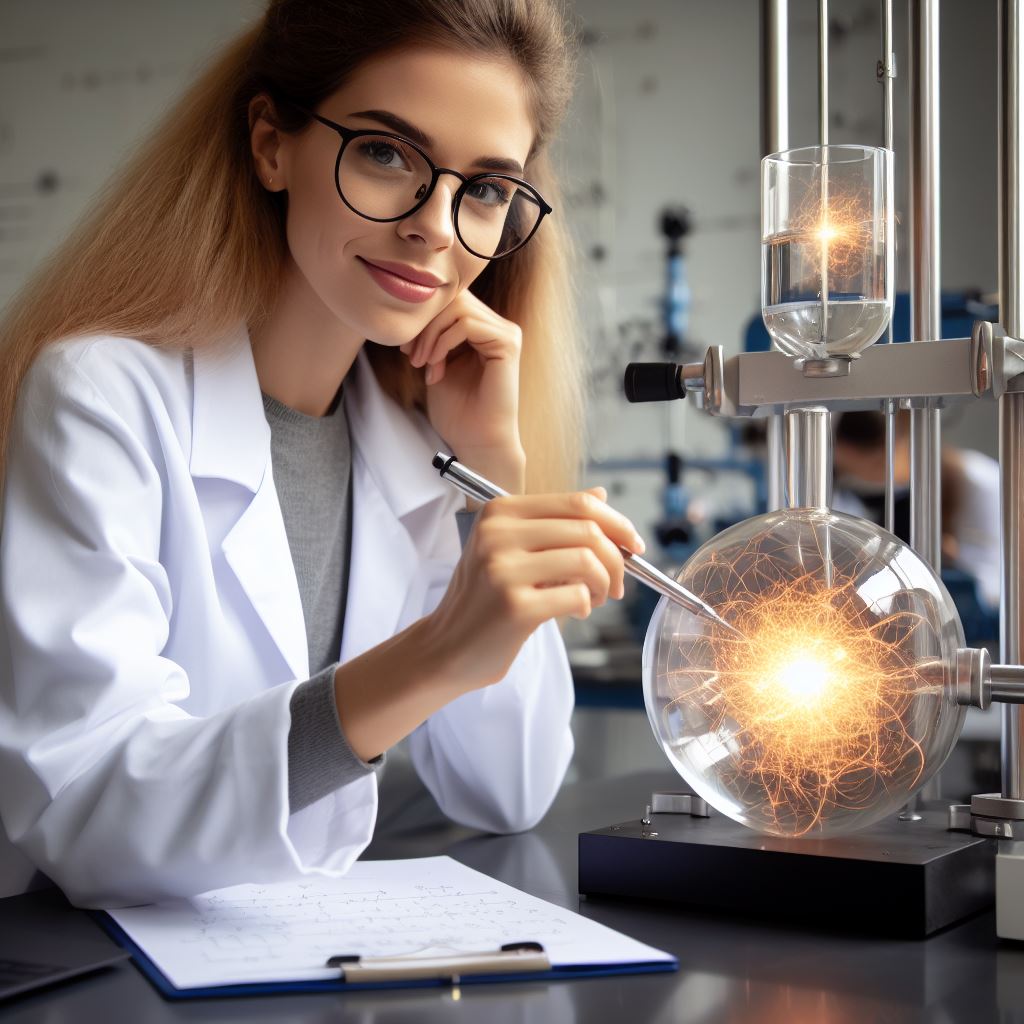Introduction
The significance of national labs in U.S. physics research cannot be overstated. They serve as dynamic hubs of scientific innovation, driving progress, and tackling complex challenges.
This blog post aims to delve deeper into the world of national labs, shedding light on their essential role in advancing physics research.
We will explore their contributions, the diverse scientific disciplines they cover, and the collaborative efforts that take place within their walls.
The purpose of this post is to provide a comprehensive understanding of the vital contributions made by national labs to the field of physics and their broader impact on scientific advancement in the United States.
Join us on this journey as we navigate through the intricacies and marvels of national labs and the role they play in shaping the future of U.S. physics research.
From cutting-edge experiments to pioneering discoveries, national labs are at the forefront of scientific exploration, and this post will showcase their remarkable contributions to the world of physics.
Definition and Functions of National Labs
Explanation of national labs and their role in advancing science and technology
- National labs are research facilities funded by the government to promote scientific advancements.
- They play a crucial role in conducting high-impact research and development projects.
- These labs focus on a wide range of scientific disciplines, including physics, chemistry, biology, and engineering.
- Their primary goal is to push the boundaries of knowledge and solve complex technological challenges.
- National labs serve as hubs for collaboration between industry, academia, and government agencies.
- They provide cutting-edge infrastructure, equipment, and expertise to drive innovation forward.
- By investing in national labs, the government ensures the advancement of science and technology in the country.
- These labs attract brilliant scientists and engineers from around the world to work on groundbreaking projects.
- They foster an environment where multidisciplinary research can flourish, leading to groundbreaking discoveries.
- Through their research efforts, national labs contribute to national security, economic growth, and public health.
Discussion on the various functions of national labs in physics research
- Basic research: National labs conduct fundamental studies to understand the laws of physics and the universe.
- Particle physics: These facilities specialize in the study of subatomic particles and fundamental forces.
- Accelerator physics: National labs develop and operate particle accelerators for high-energy physics experiments.
- Materials science: They investigate the properties and behavior of materials at the atomic and molecular level.
- Nanotechnology: National labs play a significant role in advancing nanoscale science and engineering.
- Quantum research: These labs explore the principles and applications of quantum mechanics.
- Computational modeling: National labs utilize powerful supercomputers to simulate complex physical systems.
- Energy research: They contribute to the development of sustainable energy sources and efficient technologies.
- Cosmology and astrophysics: National labs study the origin, evolution, and structure of the universe.
- Collaborative projects: These labs collaborate with universities and industry to address research challenges.
- Training and education: National labs provide opportunities for students and researchers to enhance their skills.
National labs form the backbone of U.S. physics research, driving innovation, and shaping the future of science and technology.
The funding and support provided by the government empower these facilities to undertake groundbreaking research endeavors.
With state-of-the-art infrastructure, diverse expertise, and multidisciplinary collaborations, national labs are at the forefront of pushing the boundaries of knowledge in the field of physics.
Contributions of National Labs to U.S. Physics Research
Overview of the historical significance of national labs in advancing physics research
National laboratories have played a crucial role in pushing the boundaries of physics research in the United States since their inception.
With a focus on scientific advancements, these labs have greatly contributed to shaping the field of physics over the years.
These labs were first established during World War II, with the primary objective of developing advanced technologies for military purposes.
As the war ended, their focus shifted towards peaceful applications of science, including physics research.
Throughout the years, national labs have evolved into centers of excellence, attracting the best scientific minds from around the world.
They have provided a collaborative environment and state-of-the-art facilities for researchers to conduct cutting-edge experiments and make significant scientific discoveries.
The national labs have consistently fostered innovation by promoting interdisciplinary collaborations among physicists, engineers, chemists, and other scientists.
This approach has proven to be invaluable in tackling complex physics problems and accelerating the pace of research.
The presence of national labs has also led to the development of strategic partnerships with academic institutions and industry.
These collaborations have facilitated the transfer of knowledge and expertise, further enhancing the impact of physics research on technological advancements in various sectors.
Examples of major breakthroughs and discoveries made by national labs in the field of physics
National laboratories have been at the forefront of numerous groundbreaking discoveries in physics, revolutionizing our understanding of the universe.
One notable example is the discovery of the Higgs boson, also known as the “God particle,” which was made at the European Organization for Nuclear Research (CERN) in collaboration with several national labs.
This discovery confirmed the existence of the Higgs field, a crucial component in the Standard Model of particle physics.
National labs have also made significant advancements in the field of nuclear physics.
The Lawrence Berkeley National Laboratory, for instance, played a crucial role in the discovery of new elements on the periodic table, expanding our knowledge of the atomic nucleus.
Additionally, national labs have been instrumental in developing advanced imaging technologies, such as electron microscopy.
Through the use of powerful electron microscopes, scientists at these labs have been able to observe atomic structures with unprecedented clarity, enabling breakthroughs in materials science and nanotechnology.
Discussion on the current efforts and projects being carried out by national labs in the U.S
National labs continue to push the frontiers of physics research through ongoing projects and initiatives.
At the Argonne National Laboratory, researchers are working on advancing energy storage technologies, aiming to develop high-capacity, long-lasting batteries for renewable energy storage and electric vehicles.
Their efforts have the potential to revolutionize the energy landscape and mitigate climate change.
The Los Alamos National Laboratory is heavily involved in the study of fusion energy.
Scientists at this lab are developing innovative techniques to harness the power of nuclear fusion, a potentially limitless and clean energy source that could transform the way we generate electricity.
National labs are also actively involved in the field of particle physics.
The Fermi National Accelerator Laboratory in Illinois, for example, is conducting experiments to understand the fundamental building blocks of matter and the forces that govern the universe.
In addition to these specific research projects, national labs continue to support a wide range of programs aimed at nurturing young talent, fostering scientific education, and promoting diversity in the field of physics.
Basically, national labs have been instrumental in advancing U.S. physics research.
Through their historical significance, major breakthroughs, and ongoing efforts, these labs continue to contribute significantly to the field, shaping our understanding of the universe and driving scientific progress.
Read: U.S. Research Scientist: Essential Tools and Techniques
Collaboration and Partnerships with Universities and Industry
Explanation of the collaborative nature of national labs with universities and industry
National labs play a crucial role in advancing U.S. physics research through their collaborative efforts with universities and industry.
The collaborative nature of these partnerships allows for the sharing of resources, expertise, and knowledge, leading to significant advancements in the field.
Transform Your Career Today
Unlock a personalized career strategy that drives real results. Get tailored advice and a roadmap designed just for you.
Start NowUniversities serve as important partners for national labs as they provide a pool of talented researchers and access to cutting-edge facilities.
Many national labs have established formal partnerships with universities, allowing for the exchange of personnel, joint research projects, and utilization of each other’s infrastructure.
This close collaboration ensures that both institutions can make the most of their resources and expertise, ultimately accelerating the pace of scientific discovery.
Similarly, national labs also actively collaborate with industry.
These partnerships bridge the gap between academia and real-world applications, enabling the translation of research findings into tangible innovations.
Industry partners’ vast resources and technological capabilities complement national labs’ theoretical and experimental expertise, fostering progress in physics research.
Examples of successful collaborations and partnerships in physics research
Several notable collaborations between national labs, universities, and industry have yielded significant breakthroughs in physics research.
One such example is the partnership between the Lawrence Berkeley National Laboratory (LBNL) and the University of California, Berkeley.
This collaboration has resulted in groundbreaking discoveries, including the development of the CRISPR-Cas9 gene-editing technology, revolutionizing the field of biotechnology.
The National Institute of Standards and Technology (NIST), the University of Maryland (UMD), and the National Science Foundation (NSF) successfully collaborate through the Joint Quantum Institute (JQI).
The JQI focuses on quantum information science and has made substantial contributions to quantum computing and quantum communication.
This collaboration highlights the power of bringing together institutions with diverse expertise to advance a specific research area.
Furthermore, national labs have also formed partnerships with industry leaders.
For instance, the Argonne National Laboratory collaborates with major corporations such as General Electric and Ford to develop advanced materials for energy storage and transportation.
These collaborations have resulted in the creation of next-generation batteries and fuel cells, paving the way for a sustainable energy future.
Importance of knowledge transfer and technology transfer between national labs, universities, and industry
Knowledge transfer and technology transfer are crucial in maximizing the impact of collaborations between national labs, universities, and industry.
National labs are at the forefront of scientific research, generating cutting-edge knowledge and developing innovative technologies.
However, to effectively translate this knowledge into practical applications, it is essential to facilitate its transfer to universities and industry.
Knowledge transfer involves sharing scientific findings, methodologies, and expertise between institutions.
Through collaborations, national labs can disseminate their research outcomes to universities and industry partners, enriching their understanding and enabling further advancements in physics research.
This exchange of knowledge ensures that the broader scientific community benefits from the discoveries made in national labs.
Additionally, technology transfer plays a pivotal role in turning research into tangible products and services. National labs often develop patented technologies with commercial potential.
By partnering with industry, these technologies can be further developed, scaled up, and brought to market.
This collaboration enables the public to benefit from the applications of physics research, driving economic growth and societal progress.
Generally, collaborations and partnerships between national labs, universities, and industry are integral to advancing U.S. physics research.
Through these collaborations, valuable resources, expertise, and knowledge are shared, resulting in groundbreaking discoveries and innovations.
The transfer of knowledge and technology between institutions ensures that research findings are effectively translated into practical applications, benefiting society and driving scientific progress.
Read: Navigating the Career Ladder: U.S. Research Scientist Paths
Uncover the Details: Physical Anthropology: Studying Human Evolution
Learn More: Women in Biomedical Engineering: Breaking Barriers
Government Funding and Support for National Labs
Overview of the sources and allocation of government funding for national labs
- National labs receive funding from various government agencies, including the Department of Energy and National Science Foundation.
- This funding is allocated based on the labs’ research priorities and potential impact on national security and economic growth.
- Government funding for national labs also covers facility maintenance, equipment upgrades, and operational costs.
- The allocation of funds is typically determined through a competitive review process, with labs submitting proposals to secure funding for specific projects.
- Overall, the government plays a critical role in providing financial resources that enable national labs to pursue cutting-edge research.
Discussion on the importance of sustained funding for the success of national labs in advancing U.S. physics research
- Sustained funding is essential for national labs to maintain continuity in research projects and long-term planning.
- With consistent financial support, labs can attract and retain top talent, fostering a vibrant scientific community.
- It allows national labs to invest in state-of-the-art equipment and infrastructure, facilitating groundbreaking discoveries.
- Stable funding ensures that labs can pursue high-risk, high-reward research initiatives that may have significant long-term benefits.
- By providing a stable funding base, the government fosters collaboration between national labs, universities, and industry partners.
- The continuity of funding also allows labs to build upon previous research and not be limited by short-term funding cycles.
- Sustained funding allows national labs to tackle complex and interdisciplinary research problems that require long-term commitment.
- It enables labs to attract international collaborations and exchange knowledge, elevating the status of U.S. physics research globally.
- Without sustained funding, national labs may struggle to maintain their scientific leadership and competitive edge.
- By investing in national labs, the government demonstrates its commitment to the advancement of U.S. physics research and scientific innovation.
Lastly, government funding and support are crucial for the success and impact of national labs in advancing U.S. physics research.
The allocation of funds and sustained financial support provide stability, attract talent, foster collaboration, and enable long-term planning and investment in cutting-edge infrastructure.
It is through this sustained funding that national labs can continue to push the boundaries of scientific knowledge, contribute to national security, and drive economic growth.
Investing in national labs demonstrates the government’s commitment to advancing scientific research and maintaining the country’s position as a global leader in physics.
Read: Pioneers of Environmental Science: U.S. Leaders and Innovators

Discover More: Transitioning: From a Biology Student to a Professional in the US
Gain More Insights: Impact of Immunology on Vaccine Development
Challenges and Future Outlook for National Labs in U.S. Physics Research
Identification of challenges faced by national labs in the current research landscape
- The increasing competition from privately funded research institutions poses a challenge for national labs.
- Limited funding restricts the resources available for national labs to conduct cutting-edge research.
- The bureaucratic nature of national labs hampers their ability to quickly adapt to changing research needs.
Discussion on the future direction and potential advancements for national labs in advancing U.S. physics research
- Collaboration and partnership with universities and private research organizations can enhance the capabilities of national labs.
- Increased public and private funding can provide national labs with the necessary resources to excel in research.
- Efforts should be made to streamline administrative processes within national labs for greater efficiency.
- Investment in cutting-edge technologies and infrastructure will enable national labs to remain at the forefront of research.
- Embracing interdisciplinary research approaches can lead to breakthroughs and advancements in U.S. physics research.
By addressing these challenges and focusing on the future direction, national labs can continue to play a vital role in advancing U.S. physics research.
Although they face obstacles such as competition from private institutions and limited funding, collaborative partnerships and increased investments can mitigate these challenges.
National labs should strive to streamline administrative processes and embrace interdisciplinary approaches to accelerate research progress.
Collaboration with universities and private research organizations is crucial for national labs to leverage their expertise and facilities effectively.
By working together, these institutions can pool their resources and knowledge to tackle complex scientific problems.
Such partnerships can enhance the capabilities of national labs and help them overcome the limitations posed by restricted funding.
Enhancing National Labs for Physics Advancement
In addition to collaboration, securing sufficient funding is crucial for national labs to advance U.S. physics research.
Increased public and private investments can provide the necessary resources for acquiring state-of-the-art equipment, attracting top researchers, and conducting groundbreaking experiments.
This funding boost will enable national labs to stay at the forefront of scientific discoveries and advancements.
Showcase Your Business Today
Reach thousands of readers actively exploring professional services. Publish your business profile and grow your audience now.
Publish NowStreamlining administrative processes within national labs is another key aspect for future advancement.
The bureaucratic nature of these institutions often slows down decision-making and hampers their ability to swiftly adapt to emerging research needs.
By streamlining processes and reducing unnecessary bureaucracy, national labs can become more agile in addressing research challenges and effectively allocating resources.
Furthermore, investing in cutting-edge technologies and infrastructure is essential for national labs to remain competitive.
By continuously upgrading their facilities, they can provide researchers with access to advanced instruments and equipment necessary to conduct cutting-edge experiments.
This commitment to technological advancement will attract top-tier scientists and allow national labs to push the boundaries of U.S. physics research.
Finally, embracing interdisciplinary research approaches is vital for national labs.
Breaking down disciplinary barriers and encouraging collaboration across various fields can spark innovation and lead to groundbreaking discoveries.
This interdisciplinary approach enables national labs to tackle complex scientific problems from multiple angles, offering fresh insights and solutions that traditional research approaches may overlook.
National labs encounter challenges in the research landscape.
However, they can overcome these by collaborating, securing funding, streamlining processes, investing in technology, and embracing interdisciplinary research.
By proactively addressing these challenges and embracing future advancements, national labs can play a key role in shaping the future of scientific discovery and innovation.
Read: The Role of Technology in Modern Environmental Science in the USA
Conclusion
Recap of the role and contributions of national labs in U.S. physics research
National laboratories play a crucial role in advancing physics research in the United States.
They provide state-of-the-art facilities, cutting-edge technologies, and a collaborative environment for scientists and researchers to conduct their studies.
These labs are home to some of the brightest minds in physics, who work tirelessly to uncover new knowledge and push the boundaries of our understanding of the universe.
Through their extensive research and development efforts, national labs have made significant contributions to various fields of physics, such as particle physics, material sciences, nuclear physics, and astrophysics.
They played a crucial role in discovering new particles, developing advanced materials, understanding nuclear reactions, and exploring the cosmos.
Their discoveries and progress have enriched our scientific knowledge and spurred technological innovations that benefit society.
Final thoughts on the significance and importance of national labs for the advancement of physics in the United States
The existence of national laboratories is vital for the continuous progress of physics research in the United States.
These labs serve as the backbone of the nation’s scientific infrastructure and provide invaluable resources and expertise to support groundbreaking research.
They foster collaboration and knowledge exchange among researchers, leading to breakthroughs in the field.
Moreover, national labs attract top talent from around the world, creating a diverse and vibrant scientific community that drives innovation and discovery.
Without national labs, the United States would face a significant gap in its ability to conduct cutting-edge physics research.
These institutions not only uphold the country’s position as a global leader in scientific exploration but also contribute to the nation’s economic growth and security.
It is crucial to continue supporting and investing in national labs to ensure the continued excellence and advancement of physics research in the United States.
Join us in our next blog chapter as we dive into a new topic and explore the frontiers of scientific discovery!
[E-Books for Sale]
The Big Book of 500 High-Paying Jobs in America: Unlock Your Earning Potential
$19.99 • 500 High-Paying Jobs • 330 pages
Explore 500 high-paying jobs in America and learn how to boost your career, earn more, and achieve success!
See All 500 High-Paying Jobs of this E-Book
1001 Professions Without a Degree: High-Paying American Jobs You Can Start Now
$19.99 • 1001 Professions Without a Degree • 174 pages
Discover 1001 high-paying jobs without a degree! Unlock career tips, skills, and success strategies for just $19.99!




